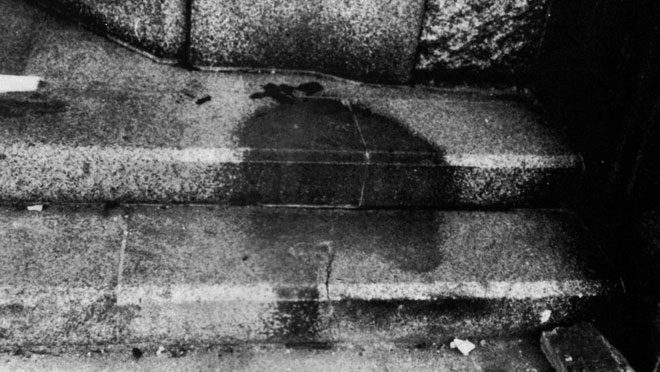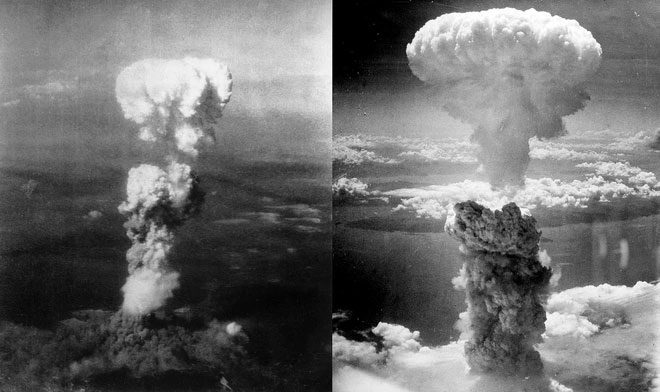The nuclear disasters of Hiroshima and Nagasaki left many mysterious questions, notably the enigmatic “shadows of people” that appeared on sidewalks and public staircases throughout the cities.
On August 6, 1945, the infamous bomb known as “Little Boy” was dropped on the city of Hiroshima, Japan. Three days later, another American B-29 bomber was dispatched to drop bombs on the city of Nagasaki.

The enigmatic shadow of a person on the steps of a bank in Hiroshima, following the nuclear explosion in August 1945. (Photo: Getty Images)
It is estimated that 140,000 residents of Hiroshima died from the blast, while the death toll in Nagasaki reached 74,000. Besides these casualty figures, the nuclear disasters of Hiroshima and Nagasaki also left many unanswered questions, particularly regarding the mysterious “shadows of people” that appeared on sidewalks and public stairways.
Many believe that these are the spirits of unfortunate individuals who perished, leaving their marks on the pavement as they could not escape. Others theorize that the bomb’s devastating power caused some material from the bodies to remain…
However, the truth behind these mysterious “ghosts” is not as frightening as one might think.

Human-shaped shadows and objects such as bicycles found scattered on sidewalks and buildings in Hiroshima and Nagasaki, after the two major cities in Japan suffered from the nuclear bombings in 1945. (Photo: Getty Images)
From a scientific perspective, researchers believe that these are merely remnants of the past left behind after both major Japanese cities were “erased” by the bomb’s explosive force.
According to Dr. Michael Hartshorne at the National Museum of Nuclear History and Science in Albuquerque, New Mexico, when each nuclear bomb detonates, the intense light and heat from the explosion rapidly spreads to the surrounding environment.
Historical evidence shows that the bomb could “whiten” concrete, stone, or walls facing the explosion.
Meanwhile, objects and people in the path of this light inadvertently shielded those behind them by absorbing light and energy.
In other words, these strange shadows are actually the true colors of the sidewalks, streets, or buildings in Hiroshima and Nagasaki before the explosion occurred, and there is no supernatural phenomenon involved.
In essence, the strange dark shadows on sidewalks and buildings are actually the appearance of those structures before the nuclear explosion. As the remaining surface was whitened, the areas that retained their normal color appeared like dark shadows.
The extreme energy released during a nuclear bomb explosion is a result of the nuclear fission process. According to the Atomic Heritage Foundation (AHF), fission occurs when a neutron strikes the nucleus of a heavy atom, such as isotopes of uranium-235 or plutonium-239. In the collision, the nucleus of that element breaks apart, releasing a tremendous amount of energy. The initial collision triggers a chain reaction that continues until all of the original material is depleted.
“The chain reaction occurs in an exponentially growing manner, lasting about 1 millisecond. This reaction divides approximately one trillion atoms in that time,” stated Alex Wellerstein, an assistant professor of science and technology studies at Stevens Institute of Technology.
The energy is transmitted in the form of photon waves with varying wavelengths, including long waves like radio waves and short waves like X-rays and gamma rays. Between long and short waves, there are visible wavelengths that contain energy perceived by the human eye as colors. However, unlike long-wave energy, gamma radiation is harmful to the human body because it can penetrate clothing and skin, causing ionization or electron loss, damaging tissues and DNA.
The gamma radiation released by atomic bombs also transmits as thermal energy, which can reach over 5,500 degrees Celsius. When it comes into contact with an object like a bicycle or a person, the energy is absorbed, creating a shadow effect between the whitened area surrounding it.
The atomic weapons used in the attacks of 1945 employed uranium-235 and plutonium-239, releasing extremely short-wavelength gamma radiation and an immense amount of heat. In fact, there may have initially been many more shadows, but most were destroyed by heat and subsequent shock waves, according to Dr. Michael Hartshorne, an expert at the National Museum of Nuclear History and Science in New Mexico.
As time passes, the long-term consequences of the radiation from these bombs have raised several important questions regarding their use. Many shadows imprinted on stone surfaces have disappeared due to weathering and erosion by wind and water. Some shadow imprints have been detached and preserved in the Hiroshima Peace Memorial Museum for future generations to observe and reflect upon.

The mushroom cloud from the atomic bomb over the skies of Hiroshima (left) and Nagasaki (right). (Photo: Getty Images)
According to the World Nuclear Association, the nuclear explosions in Hiroshima and Nagasaki had a destructive power equivalent to 16,000 tons of TNT, releasing a thermal energy pulse that spread over an area of approximately 13 square kilometers of the city.
Nearly a quarter of the population in Hiroshima died instantly when the bomb exploded. Another quarter died from the effects of radiation poisoning and cancer in the months that followed.
To this day, the bombings are still considered one of the most controversial topics and left the heaviest consequences in human history.


















































